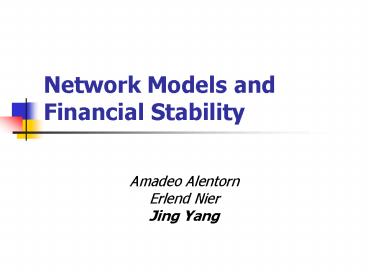Network Models and Financial Stability PowerPoint PPT Presentation
1 / 23
Title: Network Models and Financial Stability
1
Network Models and Financial Stability
- Amadeo Alentorn
- Erlend Nier
- Jing Yang
2
Greenspans open letter
3
Financial System and Real Economy
Financial System
Savings
Investment
4
Research questions
- How the generic structure of banking system
affect resilience to systemic failure. - How the resilience of the inter-bank network to
shocks relates to the following key parameters of
the system - the capacity of banks to absorb shocks
- the size of inter-bank exposures
- the degree of connectivity
- the degree of concentration of the banking
sector.
5
Network approach
- Existing economics theory
- Allen and Gale (2000)
- Studied two types of network a complete
structure and an incomplete structure. - Nodes in a network represent banks and links
represent financial obligations between banks. - Results depends on the pattern of
interconnectedness - 1. In a complete structure, the initial impact
of financial stress may be attenuated - 2. An incomplete structure is more prone to
contagion
6
- Real world networks
- 1. power-law degree distribution
- 2. clustering
- 3. small degree of separation small world
phenomenon
7
Empirical studies
- Empirical research on the importance of interbank
linkages as a channel of contagion - Sheldon and Maurer (1998) for Switzerland
- Furfine (1999) for the US
- Upper and Worms (2000) for Germany
- Wells (2002) for the UK
- Boss, Elsinger, Summer and Thurner (2003) for
Austria. - Limitation no generic relationship between
stability of a financial system and features of
the network.
8
The Eboli (2004) Framework
- Network is a directional graph, where links
represent exposures. - Each of N nodes (banks) is connected to a source
(ie source of shock/loss). - Each of the N nodes is assigned a sink
(representing net worth). - Flow network losses flow across a network of
banks - When losses reach a bank, they are absorbed by
the sink, or flow further through inter-bank
links.
9
Extending the Eboli (2004) framework
- Identify source with banks external assets
- Introduce depositors as the second sink
- deposits are senior to interbank, in turn, senior
to net worth - Introduce a probability law describing likelihood
of interbank link between any two nodes (banks) - symmetric structures (random graph a la Erdos and
Reiny) - or asymmetric structures (eg power law).
10
(No Transcript)
11
(No Transcript)
12
- Demonstration
- Construction of a banking system
- Construction of individual banks balance sheet
- Shock propagation
- Experiments
13
- Simulation results
14
Experiments
- Four parameters
- Number of nodes (N)
- Erdos-Reyni probability (p)
- Percentage of Interbank assets (w)
- Net worth (c)
- In each of the following experiments, we vary one
parameter at a time - In each experiment, we shock one bank at a time
to study the default dynamics, then take average
across all banks.
15
How does bank capitalisation affect contagion?
weakly monotonic and negative relationship between bank capitalisation and contagion contagion does not decrease linearly in bank capitalisation for low values of net worth, a slight decrease in net worth leads to a sharp increase in number of failures
16
A multiple rounds of default scenario
17
How does the size of interbank exposure affect
contagion?
A decrease in the percentage of external assets has two opposing effects shock propagation and shock absorption When the net worth is still sufficiently small, the shock propagation dominates the shock absorption. Nonlinear relationship for different levels of percentage of external assets, a banking system can achieve same level of resilience.
18
How does likelihood of interbank exposure affect
contagion?
Interbank connections have two opposing effects shock-transmitter and shock-absorber. two mechanisms dominate over different ranges, generating an M-shaped graph. an interesting dynamic between interbank linkages and net worth
19
How does banking concentration affect contagion
contagion risk monotonically increases in size of the shock regardless of concentration level. The more concentrated is the banking system, a higher risk of contagion for same shock.
20
- Interdependence of the parameters
21
Inter-dependence of net worth and connectivity
22
Heterogeneous networks
Nonlinearity as the degree of centrality increases, contagious defaults first increase, but then start to decrease, as the number of connections to the central node start to lead to greater dissipation of the shock.
23
Summary
- Under-capitalised banks impose an externality on
other banks in the system. - Decreases in net worth increase the number of
contagious defaults and that this effect is
non-linear. - Contagion risk first increases with the
connectivity of the banking system, then
decreases. - More concentrated banking systems tend to be more
prone to systemic meltdown ?too systemic to
fail ?

